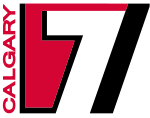CICT-DT
 | |
| Calgary, Alberta Canada | |
|---|---|
| Branding |
Global Calgary (general) Global News (newscasts) |
| Slogan | Think. Global. |
| Channels |
Digital: 41 (UHF) Virtual: 2.1 (PSIP) |
| Translators | see below |
| Affiliations | Global (secondary; 1988–2000, primary affiliate; 2000–present) |
| Owner | Corus Entertainment |
| First air date | October 8, 1954 |
| Call letters' meaning |
Canadian Independent Calgary Television or Calgary Independent Channel Two |
| Sister station(s) |
TV: CISA-DT Radio: CHQR, CFGQ-FM, CKRY-FM |
| Former callsigns |
CHCT-TV (1954–1968) CFAC-TV (1968–1990) CKKX-TV (1990–1993) CICT-TV (1993–2011) |
| Former channel number(s) |
Analog: 2 (VHF, 1954–2011) |
| Former affiliations |
CBC (1954–1975) independent (1975–2000) |
| Transmitter power | 50 kW |
| Height | 378 m |
| Transmitter coordinates | 51°4′21.1″N 114°15′38.3″W / 51.072528°N 114.260639°W |
| Website | Global Calgary |
CICT-DT, virtual channel 2 (UHF digital channel 41), is a Global owned-and-operated television station located in Calgary, Alberta, Canada. The station is owned by Corus Entertainment. CICT's studios are located on 23 Street Northeast and Barlow Trail in Calgary, near the Mayland Heights neighborhood; and its transmitter is located near Old Banff Coach Road/Highway 563 and Artists View Drive, near the Calgary city limits. It serves as the master control hub for all 12 Global owned-and-operated stations across Canada.
This station can also be seen on Shaw Cable (corporate sister through parent company Shaw Communications) channel 7 and in high definition on digital channel 211, Bell TV channel 244, Rogers Personal TV channel 118. On Shaw Direct, the channel is available on 338 (Classic) or 017 (Advanced), and in high definition on channel 015 (Classic) or 515 (Advanced).
History
CICT-TV first signed on the air on October 8, 1954 as CHCT, and was the first television station in the province of Alberta (as a result, it is also the oldest television station in the country that is part of the Global Television Network). The station was originally an affiliate of CBC Television. Its studios, offices and transmitter facility were located on a hill seven miles (11 km) west of the city. The station was owned by Calgary Television Ltd., a consortium of Calgary radio stations CFCN, CFAC and CKXL. The "CT" in CHCT stood for "Calgary Television".
During the construction of the transmitter, the 70 foot, 5 ton antenna was being hoisted on the top of the 600-foot (180 m) tower when the cable snapped and the antenna fell all the way down the tower to imbed itself 15 feet (4.6 m) in the ground. No one was injured in the accident, and the antenna was able to be repaired, but the station’s launch was delayed by 10 days. A year later, CHCT moved its studios and offices from the transmitter site on Old Banff Coach Road, to a renovated badminton club/sea cadet drill hall on 955 Rideau Road S.W. Calgary.

Notable programs that were produced at the original studio include Klara’s Korner, a cooking show that was in national syndication for many years; Yan Can Cook, a cooking show hosted by Martin Yan which later aired for many years on PBS in the United States; Stampede Wrestling, which was produced for over 20 years, finding loyal audiences worldwide; and It Figures, which originated at the station and was produced for nearly 20 years.
In 1957, CKXL Ltd. sold its share in Calgary Television Ltd. to Fredrick Shaw, who had recently sold his share in CKXL-AM to Tel-Ray Ltd. CFCN sold off its share in 1961 when it opened its own station, CFCN-TV. In 1968, Tel-Ray sold its stake to Selkirk Communications, who changed the callsign to CFAC-TV to match CFAC radio, of which Selkirk was part-owner (and full owner from 1971). On September 1, 1975, after the CBC launched its own station in Calgary, CBRT (channel 9), CFAC-TV disaffiliated from CBC and became an independent station. In 1979, the station branded itself as "2&7", the latter channel number referring to both its cable location and to sister station CFAC-TV7 in Lethbridge (now CISA. For a number of years afterwards, it continued to use the old CFAC "star" logo alongside the 2&7 logo.
In 1981, the station moved to its new home, the Calgary Television Centre, a move reflecting its growth since its disaffiliation from the CBC. After obtaining the television rights to the Calgary Flames National Hockey League franchise the year before, the station purchased a seven-camera mobile unit soon after. The station has been the Flames’ television partner since 1980. In the fall of 1982, the station became the first station in Calgary to begin broadcasting a 24-hour schedule. Programs seen during the overnight hours consisted of movies and reruns of The Jackie Gleason Show, among other shows.
Although it continued to nominally be an independent station, in 1988, CFAC-TV began airing some programs from the Global Television Network. In 1989, Maclean-Hunter purchased Selkirk Communications, but due to CRTC ownership regulations at the time (Maclean-Hunter already owned CFCN-TV), CFAC-TV was sold to Western International Communications (WIC). A year after WIC bought channel 2, it changed the call letters to CKKX-TV. In 1992, CKKX’s news operations were expanded with the acquisitions of a satellite uplink truck and a fleet of electronic news gathering microwave trucks.

On September 7, 1993, CKKX changed its callsign to CICT-TV, and also took on the brand of "Calgary 7", referring to the station’s cable channel. WIC's properties were split between Shaw Communications and Canwest in 1998. This move required Canadian Radio-television and Telecommunications Commission (CRTC) approval, the plans for which were filed in 1999 and approved in 2000. Canwest acquired WIC's television assets, including CICT; incidentally, Shaw later bought Canwest's assets amidst the latter company seeking creditor protection in 2009, with the properties becoming the present-day Shaw Media (which is based in the same city).
On September 4, 2000, CICT joined the Global Television Network full-time as an owned-and-operated station, along with fellow Alberta stations CITV-TV in Edmonton and CISA in Lethbridge. By 2001, CICT-TV began relays in Drumheller (CICT-TV-1) and Banff (CICT-TV-2).
Programming
CICT airs the entire Global programming lineup, operating on the same schedule as its Edmonton sister station CITV-DT. All non-news programming and some Calgary-based newscasts are also aired on fellow sister station CISA-TV in Lethbridge.
News operation


CICT presently broadcasts 46½ hours of locally produced newscasts each week (with 7½ hours on weekdays, and 4½ hours each on Saturdays and Sundays); in regards to the number of hours devoted to news programming, it is the highest local newscast output out of any English-language television station in the Calgary market.
On April 11, 2007, CICT-DT became the first television station in Calgary to use a helicopter for newsgathering. Named "Global 1", it provides traffic reports on the Morning News in combination with in-studio traffic segments, and is also intended to provide breaking news coverage. The helicopter is also shared with CHQR (770 AM) during the morning and afternoon rush hour periods. CICT became the first television station in Calgary, and the second television station in the province of Alberta, to begin broadcasting its local newscasts in high definition on November 22, 2010; a new virtual set for the newscasts was also introduced on that date.
On September 11, 2011, CICT debuted a two-hour Sunday morning newscast, running from 8-10 a.m. Mountain Time.[1] On August 27, 2012, the station expanded its weekday morning newscast to four hours, with the addition of a half-hour at 5 a.m., the 5-6 a.m. hour of the newscast being titled the Early Morning News; in addition on September 2, 2012, the station expanded its Sunday morning newscast to three hours with an additional hour at 7 a.m. The expansions of the morning newscasts were part of a benefits package that was included as a condition of the sale of the Global network to Shaw Communications.[2]
Notable former on-air staff
- Ashleigh Banfield (was with MSNBC, and TruTV, now weekday mid-morning anchor for CNN)
- Sandra Jansen - Member of the Legislative Assembly of Alberta for Calgary-North West
- Bruce McAllister - Member of the Legislative Assembly of Alberta for Chestermere-Rocky View
- Mike Toth (now a freelance writer, TV and radio host, and professional speaker and broadcaster coach in Toronto)
- Ed Whalen - news and sports director, news anchor and editorial; host of Stampede Wrestling; later sports anchor and Calgary Flames play-by-play announcer (was with CICT since its sign-on; also worked for CFAC radio and the Calgary Sun; deceased)
Transmitters
| Station | City of licence | Channel | ERP | HAAT | Transmitter Coordinates |
| CICT-TV-1 | Drumheller | 8 (VHF) | 0.009 kW | NA | 51°27′1″N 112°44′10″W / 51.45028°N 112.73611°W |
| CICT-TV-2 | Banff | 13 (VHF) | 0.009 kW | NA | 51°11′53″N 115°36′47″W / 51.19806°N 115.61306°W |
Digital television
Digital channel
| Channel | Video | Aspect | PSIP Short Name | Programming[3] |
|---|---|---|---|---|
| 2.1 | 1080i | 16:9 | CICT-DT | Main CICT-DT programming / Global |
Analogue-to-digital conversion
CICT-DT received a construction permit for channel 41 on March 5, 2009 and began broadcasting on May 25, 2009.[4] On August 31, 2011, when Canadian television stations in CRTC-designated mandatory markets transitioned from analogue to digital broadcasts,[5] the station's digital signal remained on UHF channel 41. However, through the use of PSIP, digital television receivers display CICT-DT's virtual channel as 2.1.
References
- ↑ http://shawmedia.ca/advertising/broadcast/television/stations/globalcalgary/schedule.asp
- ↑ Global News Boosts Local Programming Across the Country, Broadcaster Magazine, May 30, 2012.
- ↑ RabbitEars TV Query for CICT
- ↑ Broadcasting Decision CRTC 2009-119, CICT-TV Calgary – Transitional digital television
- ↑ Digital Television - Office of Consumer Affairs (OCA)
External links
- Global Calgary
- Canadian Communications Foundation - CICT-TV History
- Query the REC's Canadian station database for CICT-TV
- Query TV Fool's coverage map for CICT